Subtotal: £21.30
Pelvicachromis subocellatus “Matadi Violet” – Ocellated K Cichlid, Ideal Aquarium Substrate Choice for Beautifully Crafted Freshwater Environments, Perfect for Beginners, Peaceful Community Fish
£11.99 Original price was: £11.99.£9.99Current price is: £9.99.
Welcome the stunning Pelvicachromis subocellatus ‘Matadi Violet’ into your aquarium. This beautiful African dwarf cichlid thrives in peaceful community tanks, showcasing vibrant colors and graceful movements. Ideal for beginners seeking elegant tropical freshwater fish, it enhances any setup effortlessly.
Species Introduction
The Pelvicachromis subocellatus, commonly known as the Matadi Violet Ocellated K Cichlid, is a vibrant and captivating freshwater fish originating from the lush river systems of the Congo Basin in Africa. This species is renowned for its striking coloration and unique patterns, making it a popular choice among aquarists seeking to enhance the beauty of their aquatic environments. The Matadi Violet exhibits a stunning array of colors, with males often displaying a rich violet hue complemented by iridescent spots, while females are typically more subdued yet equally beautiful. These charming cichlids thrive in a variety of freshwater habitats, including slow-moving rivers and densely vegetated areas, where they find ample hiding spots among rocks and plants. As a member of the African dwarf cichlid family, they are well-suited for community tanks, particularly when paired with other peaceful species. Understanding their natural habitat and behavior is essential for creating an environment that allows these beautiful creatures to flourish.
Care Requirements Dashboard
| Optimal Living Conditions | |
|---|---|
| Water Temperature | 24-27°C (75-81°F) |
| pH Level | 6.5-7.5 |
| Water Hardness | 4-12 dKH |
| Minimum Tank Size | 80L (20 gal) |
| Salinity | Freshwater |
| Care Level | Beginner Friendly |
✓ Care Level: Easy
Tank Size: Minimum 20 gallons
Water Temperature: 75°F – 82°F (24°C – 28°C)
pH Level: 6.0 – 7.5
Hardness: 5 – 15 dGH
Natural Behavior & Temperament
The Pelvicachromis subocellatus is known for its peaceful demeanor, making it a suitable addition to community tanks. These cichlids exhibit fascinating social behaviors, often establishing territories and engaging in playful interactions with their tank mates. Males can display territorial aggression during breeding periods, but generally, they coexist harmoniously with other peaceful species. Their natural behavior includes foraging along the substrate, exploring crevices, and utilizing hiding spots created by decorations and plants. Providing ample space and hiding areas will help minimize stress and encourage natural behaviors, allowing these fish to thrive in a well-planned aquarium environment.
Tank Setup Guide
Setting up a tank for Pelvicachromis subocellatus requires careful consideration of their natural habitat. A well-planned aquascape that mimics their environment will not only enhance their beauty but also promote their well-being. Begin with a minimum tank size of 20 gallons, filled with clean, dechlorinated water. The substrate should consist of fine gravel or sand, allowing these cichlids to forage comfortably. Incorporate plenty of hiding spots using rocks, driftwood, and live plants to create a natural environment that mimics their native habitat. Plants such as Java moss, Anubias, and Cryptocoryne are excellent choices, providing cover and enhancing water quality. Ensure that the tank is well-filtered to maintain water clarity and quality, as these fish prefer clean environments. Lighting should be moderate, allowing for plant growth while providing a comfortable atmosphere for the fish.
Water Quality Management
Maintaining optimal water quality is crucial for the health of Pelvicachromis subocellatus. Regular testing of water parameters such as pH, temperature, and hardness is essential to ensure a stable environment. The ideal pH level for these cichlids ranges from 6.0 to 7.5, with a temperature maintained between 75°F and 82°F. Hardness levels should be kept between 5 and 15 dGH. Regular water changes of 25% every two weeks will help remove toxins and maintain water clarity. Additionally, using a quality filtration system will aid in keeping the water clean and oxygenated. Monitoring ammonia, nitrite, and nitrate levels is vital, as elevated levels can lead to stress and health issues. By prioritizing water quality management, aquarists can create a thriving environment for their Pelvicachromis subocellatus.
Feeding & Nutrition
Feeding Pelvicachromis subocellatus a balanced diet is essential for their growth and vibrant coloration. These cichlids are omnivorous and thrive on a varied diet that includes high-quality pellets, flakes, and frozen or live foods. A diet rich in protein will support their health and enhance their natural colors. It is recommended to feed them small portions two to three times a day, ensuring that all food is consumed within a few minutes to prevent water quality issues. Incorporating occasional treats such as brine shrimp, daphnia, and bloodworms will provide essential nutrients and stimulate their natural foraging behavior. Additionally, providing vegetable matter, such as blanched spinach or zucchini, can contribute to their overall health. By offering a diverse diet, aquarists can ensure the well-being and vibrancy of their Pelvicachromis subocellatus.
Compatibility Guide
✓ Peaceful Community Fish
Compatible Tank Mates: Tetras, Rasboras, Corydoras, Guppies, Other Peaceful Cichlids
Pelvicachromis subocellatus is known for its peaceful nature, making it an excellent choice for community tanks. They coexist well with a variety of peaceful species, including tetras, rasboras, and corydoras. When selecting tank mates, it is essential to avoid aggressive or overly territorial fish, as this can lead to stress and aggression. Ideal companions include small, peaceful fish that occupy different levels of the tank, allowing for a harmonious environment. Careful consideration of tank dynamics and the introduction of new fish should be done gradually to minimize stress and establish a balanced community. By fostering a peaceful environment, aquarists can enjoy the beauty and charm of Pelvicachromis subocellatus alongside their aquatic companions.
Health & Wellness
Monitoring the health of Pelvicachromis subocellatus is crucial to ensuring their well-being. Common health issues include stress from poor water quality, aggression from tank mates, and dietary deficiencies. Signs of stress may manifest as erratic swimming behavior, loss of appetite, or hiding excessively. Regular water testing and maintenance are essential to prevent health issues related to water quality. Additionally, providing a balanced diet and ensuring compatibility with tank mates will help prevent stress-related problems. If health issues arise, prompt attention is necessary. Quarantine any new fish before introducing them to the main tank to prevent the spread of disease. By prioritizing health and wellness, aquarists can enjoy the vibrant beauty of Pelvicachromis subocellatus for years to come.
Breeding Information
Breeding Pelvicachromis subocellatus can be a rewarding experience for aquarists. These cichlids are known to be relatively easy to breed in captivity, provided that the right conditions are met. To encourage breeding, it is essential to maintain optimal water parameters and provide suitable hiding spots for spawning. Males will display vibrant colors and engage in courtship behaviors to attract females. Once a pair has formed, they will select a flat surface, such as a rock or a breeding cave, to lay their eggs. The female will typically lay between 50 to 150 eggs, which she will guard diligently. After hatching, the fry will remain close to their parents for protection. It is crucial to provide a separate breeding tank or ample hiding spots in the main tank to ensure the safety of the fry. By understanding the breeding behaviors of Pelvicachromis subocellatus, aquarists can successfully raise the next generation of these beautiful cichlids.
Acclimation Process
Acclimating Pelvicachromis subocellatus to a new tank environment is a critical step in ensuring their health and well-being. When introducing these cichlids to a new aquarium, it is essential to take the time to acclimate them slowly to prevent shock. Begin by floating the sealed bag containing the fish in the tank for about 15-20 minutes to equalize the temperature. After this, gradually introduce small amounts of tank water into the bag over the course of an hour. This process helps the fish adjust to the new water parameters. Once acclimated, gently release the fish into the tank, avoiding the introduction of bag water to minimize contamination. Monitoring the fish closely for signs of stress or illness during the first few days in their new home is crucial. By following a careful acclimation process, aquarists can ensure a smooth transition for their Pelvicachromis subocellatus.
Long-term Care
Providing long-term care for Pelvicachromis subocellatus involves understanding their lifecycle and growth expectations. These cichlids typically reach a maximum length of around 4-5 inches, with males being slightly larger than females. As they grow, it is essential to monitor their environment and adjust tank conditions accordingly. Regular maintenance, including water changes and substrate cleaning, will help maintain optimal living conditions. Additionally, keeping an eye on their behavior and health will allow for early intervention if any issues arise. With proper care, Pelvicachromis subocellatus can live for several years, bringing joy and beauty to the aquarium. By prioritizing their needs and creating a supportive environment, aquarists can enjoy the vibrant colors and engaging behaviors of these delightful cichlids for a long time.
Natural Habitat Recreation
Recreating the natural habitat of Pelvicachromis subocellatus in the aquarium is essential for their well-being. These cichlids thrive in environments that mimic their native river systems, characterized by slow-moving waters and abundant vegetation. To achieve this, aquarists should focus on creating a biotope that includes fine substrate, such as sand or small gravel, along with plenty of hiding spots using rocks, driftwood, and live plants. Incorporating plants like Java fern, Anubias, and floating vegetation will enhance the aesthetic appeal while providing cover and breeding sites. Additionally, maintaining stable water parameters that reflect their natural habitat will help promote healthy growth and behavior. By carefully designing the aquarium to replicate their natural environment, aquarists can ensure the happiness and health of Pelvicachromis subocellatus.
Seasonal Care Adjustments
Seasonal changes can impact the care of Pelvicachromis subocellatus, and aquarists should be prepared to make necessary adjustments. During warmer months, it is important to monitor water temperature closely, as higher temperatures can stress the fish. Ensuring proper aeration and water circulation will help maintain comfortable conditions. In colder months, heating systems may be required to maintain stable temperatures within the ideal range of 75°F to 82°F. Additionally, lighting schedules may need to be adjusted to mimic natural daylight cycles, promoting healthy plant growth and fish behavior. By being attentive to seasonal changes and adjusting care routines accordingly, aquarists can provide optimal living conditions for their Pelvicachromis subocellatus throughout the year.
Expert Tips
For those looking to enhance their experience with Pelvicachromis subocellatus, here are some expert tips to consider. First, always research and understand the specific needs of this species to ensure a thriving environment. Regularly monitor water parameters and perform maintenance to prevent any issues. Providing a varied diet will not only enhance their health but also promote vibrant coloration. Additionally, consider creating multiple hiding spots to reduce stress and allow for natural behaviors. Observing their interactions and behaviors can provide valuable insights into their well-being. Lastly, joining aquarist communities can offer support and shared experiences, enhancing your knowledge and enjoyment of keeping these beautiful cichlids. By following these expert tips, you can create a rewarding and fulfilling aquarium experience with Pelvicachromis subocellatus.
Troubleshooting
Troubleshooting common issues with Pelvicachromis subocellatus is essential for maintaining a healthy aquarium. If you notice signs of stress, such as hiding or erratic swimming, check water parameters immediately. Elevated ammonia or nitrite levels can be harmful, so regular testing is crucial. If aggression occurs, consider rearranging the tank to disrupt established territories or adding more hiding spots. In cases of poor appetite or lethargy, evaluate the diet and ensure it is varied and nutritious. Quarantining new fish before introducing them to the main tank can prevent the spread of disease. By being proactive and addressing issues promptly, aquarists can ensure the health and happiness of their Pelvicachromis subocellatus.
Scientific Background
The Pelvicachromis subocellatus belongs to the family Cichlidae, which encompasses a diverse range of freshwater fish known for their unique behaviors and vibrant colors. This species is part of the Pelvicachromis genus, which includes several other dwarf cichlids. Understanding the scientific classification and background of these fish can provide valuable insights into their care and behavior. Research into their natural habitat and behaviors has highlighted the importance of creating environments that mimic their native conditions. Conservation efforts are also critical, as many cichlid species face threats from habitat loss and overfishing. By supporting sustainable practices and promoting awareness, aquarists can contribute to the preservation of these beautiful fish and their ecosystems.
Advanced Care Techniques
For experienced aquarists looking to provide exceptional care for Pelvicachromis subocellatus, consider implementing advanced techniques to enhance their environment. Utilizing a planted tank with a variety of species can create a more dynamic habitat that encourages natural behaviors. Regularly rotating decorations and plants can stimulate exploration and reduce boredom. Additionally, experimenting with different feeding techniques, such as target feeding or using feeding rings, can enhance their foraging instincts. Monitoring breeding behaviors and providing optimal conditions for fry can also lead to successful breeding experiences. By employing these advanced care techniques, aquarists can create a thriving environment for their Pelvicachromis subocellatus, ensuring their health and happiness.
Frequently Asked Questions
Q: What tank size is required for Pelvicachromis subocellatus “Matadi Violet”?
Pelvicachromis subocellatus, commonly known as the Ocellated K Cichlid, thrives in a minimum tank size of 100 litres. This provides ample swimming space and territories for these fish, as they can be somewhat territorial, especially during breeding. A larger tank can help mitigate aggression and establish a more harmonious environment. It’s essential to ensure that the tank is well-planted with hiding spots, as this will help them feel secure and reduce stress. Additionally, a tank size of this capacity allows for better water quality maintenance, which is vital for their health and wellbeing.
✓ Expert Tip
Consider using a larger tank if you plan to keep multiple pairs or community fish to minimise territorial disputes.
Q: What water parameters do Pelvicachromis subocellatus require?
For optimal health, Pelvicachromis subocellatus prefers soft to moderately hard water, with a pH ranging from 6.5 to 7.5. The water temperature should ideally be maintained between 24°C to 28°C. Regular testing of water parameters is essential, as fluctuations can lead to stress and health issues. A well-maintained filtration system is crucial to keep the water clean. Frequent partial water changes (about 20% weekly) will help maintain stable conditions. Remember to use a water conditioner to remove harmful chemicals from tap water before adding it to the tank.
✓ Expert Tip
Invest in a quality water testing kit to regularly monitor parameters and ensure a stable environment.
Q: How often should I feed Pelvicachromis subocellatus?
Feeding Pelvicachromis subocellatus should be done two to three times a day. A varied diet is essential for their health; consider high-quality pellets, flakes, and occasional live or frozen foods such as brine shrimp or bloodworms. Ensure that the portions are small enough for them to consume within a few minutes to prevent overfeeding, which can lead to water quality issues. Observing their feeding habits can also provide insight into their overall health, as a lack of appetite may indicate stress or illness.
✓ Expert Tip
Consider rotating different food types to ensure a balanced diet and to encourage natural foraging behaviours.
Q: What are the best tank mates for Pelvicachromis subocellatus?
Pelvicachromis subocellatus can be sociable with various community fish, but caution is advised. Suitable tank mates include peaceful species such as tetras, rasboras, and certain catfish. Avoid aggressive or fin-nipping species, as they may stress these cichlids. It is advisable to introduce tank mates simultaneously, as this can help reduce territorial behaviour. Providing plenty of hiding spots will also allow the Ocellated K Cichlid to establish its territory while feeling secure in the presence of other fish.
✓ Expert Tip
Always monitor interactions when introducing new fish to ensure compatibility and reduce stress.
Q: How do I properly acclimatise Pelvicachromis subocellatus to my aquarium?
Acclimatisation is crucial for reducing stress and ensuring the health of your new fish. Begin by floating the sealed bag containing the fish in your aquarium for about 15-20 minutes to equalise the temperature. Next, gradually introduce small amounts of aquarium water into the bag every 5-10 minutes. After about an hour, gently net the fish into the tank, avoiding adding bag water to the aquarium. This method helps them adjust to the new water conditions, reducing the risk of shock.
✓ Expert Tip
Always observe your fish for signs of stress or illness during and after acclimatisation.
Q: What are the signs of healthy Pelvicachromis subocellatus?
Healthy Pelvicachromis subocellatus display vibrant colours, clear eyes, and active behaviour. They should be swimming actively and exploring their environment rather than hiding excessively. Healthy individuals will also exhibit a good appetite and show interest in feeding. Regularly checking for any signs of distress, such as faded colours, clamped fins, or lethargy, is vital. If these signs are observed, it may indicate stress or illness, warranting immediate attention to water quality and tank conditions.
✓ Expert Tip
Keep a close eye on their behaviour and colouration, as these are key indicators of their wellbeing.
Q: How do I successfully breed Pelvicachromis subocellatus?
Breeding Pelvicachromis subocellatus can be a rewarding experience. To encourage breeding, maintain a stable tank environment with optimal water parameters and provide plenty of hiding spots and caves for spawning. A breeding pair will often display courtship behaviours, including colour changes and dance-like movements. Once the female lays eggs, she will guard them vigorously. After hatching, the fry will remain close to their parents for protection. It is advisable to provide infusoria or finely crushed flakes for the fry until they are large enough to eat regular food.
✓ Expert Tip
Consider separating the breeding pair after spawning to prevent aggression towards the fry.
Q: What temperature should I maintain for Pelvicachromis subocellatus?
The ideal temperature range for Pelvicachromis subocellatus is between 24°C to 28°C. Maintaining a stable temperature within this range is crucial for their metabolic health and overall wellbeing. Fluctuations can lead to stress and susceptibility to diseases. It is advisable to use a reliable aquarium heater and thermometer to monitor and adjust the temperature as necessary. Regular checks will ensure that the conditions remain optimal, especially during seasonal changes.
✓ Expert Tip
Position the heater near the filter outlet for even temperature distribution throughout the tank.
Q: How long do Pelvicachromis subocellatus typically live in captivity?
In captivity, Pelvicachromis subocellatus can live for approximately 5 to 10 years, provided they are cared for in a suitable environment. Factors such as water quality, diet, and tank conditions heavily influence their lifespan. Regular maintenance of the aquarium and monitoring of water parameters are essential for promoting longevity. A stress-free environment with proper tank mates and a balanced diet will contribute significantly to their overall health and lifespan.
✓ Expert Tip
Keep a consistent care routine to enhance the quality of life for your aquatic companions.
Q: What type of substrate is most suitable for Pelvicachromis subocellatus?
Pelvicachromis subocellatus thrives best in a soft, sandy substrate that allows for natural behaviours such as digging. A fine sand substrate mimics their natural habitat and provides an ideal environment for spawning and foraging. Additionally, the substrate should be clean and free from sharp edges to prevent injury. Regular cleaning is necessary to maintain water quality and prevent the accumulation of waste. Incorporating plants and decorations will also help enhance their habitat, providing both cover and aesthetic appeal.
✓ Expert Tip
Consider using a substrate heater if you have a planted tank to promote healthy root growth.
Q: What behavioural patterns should I expect from Pelvicachromis subocellatus?
Pelvicachromis subocellatus exhibits a range of interesting behaviours. They are generally peaceful but can display territorial behaviour, especially during breeding. Males will often display vibrant colours and engage in courtship dances to attract females. They enjoy exploring their environment, often sifting through substrate in search of food. These cichlids are known to establish territories and will defend them against intruders. Providing plenty of hiding spots and plants will encourage natural behaviours and reduce aggression.
✓ Expert Tip
Observe their interactions closely, as understanding their behaviour can help in creating a harmonious aquarium environment.
Q: How can I prevent common diseases in Pelvicachromis subocellatus?
Preventing diseases in Pelvicachromis subocellatus primarily revolves around maintaining excellent water quality and a stress-free environment. Regular water changes, proper filtration, and monitoring water parameters are essential. Avoid overfeeding and ensure a balanced diet to keep them healthy. Quarantine new fish before introducing them to the main tank to prevent disease transmission. Additionally, keeping the aquarium clean and well-maintained will help reduce the risk of infections and parasites.
✓ Expert Tip
Consider adding aquarium salt to your tank as a preventive measure against certain diseases, but consult resources for appropriate use.
Q: What lighting conditions do Pelvicachromis subocellatus prefer?
Pelvicachromis subocellatus prefers moderate lighting that mimics their natural habitat. Bright lighting can be stressful, so consider using a dimmable LED light or placing floating plants to diffuse the light. This not only creates a comfortable environment for the fish but also promotes plant growth if you have a planted aquarium. A light cycle of about 10 to 12 hours per day is ideal, allowing a consistent day-night rhythm, which is essential for their wellbeing.
✓ Expert Tip
Utilise a timer for your aquarium lighting to maintain a consistent light cycle, which can aid in plant growth and fish health.
Q: How do I recognise stress in Pelvicachromis subocellatus?
Signs of stress in Pelvicachromis subocellatus may include hiding excessively, loss of colour vibrancy, and erratic swimming patterns. They may also display clamped fins or appear lethargic. Stress can stem from various factors, including poor water quality, aggressive tank mates, or unsuitable environmental conditions. Regular monitoring of their behaviour and environment is crucial to identify any changes that may indicate stress, allowing for timely intervention to restore a healthy environment.
✓ Expert Tip
Address any stressors immediately, as prolonged stress can lead to severe health issues.
Q: What natural habitat conditions should I replicate for Pelvicachromis subocellatus?
To replicate the natural habitat of Pelvicachromis subocellatus, aim for a soft, sandy substrate with plenty of hiding spots, such as caves and dense vegetation. They inhabit slow-moving waters in their natural environment, so consider incorporating plants and driftwood to create a similar setting. Maintaining stable water parameters, including soft, slightly acidic to neutral pH, will also help mimic their natural conditions. Additionally, ensuring proper filtration to keep the water clean and well-oxygenated is crucial for their health.
✓ Expert Tip
Incorporate natural elements to create a biotope that reflects their wild habitat, enhancing their comfort and health.


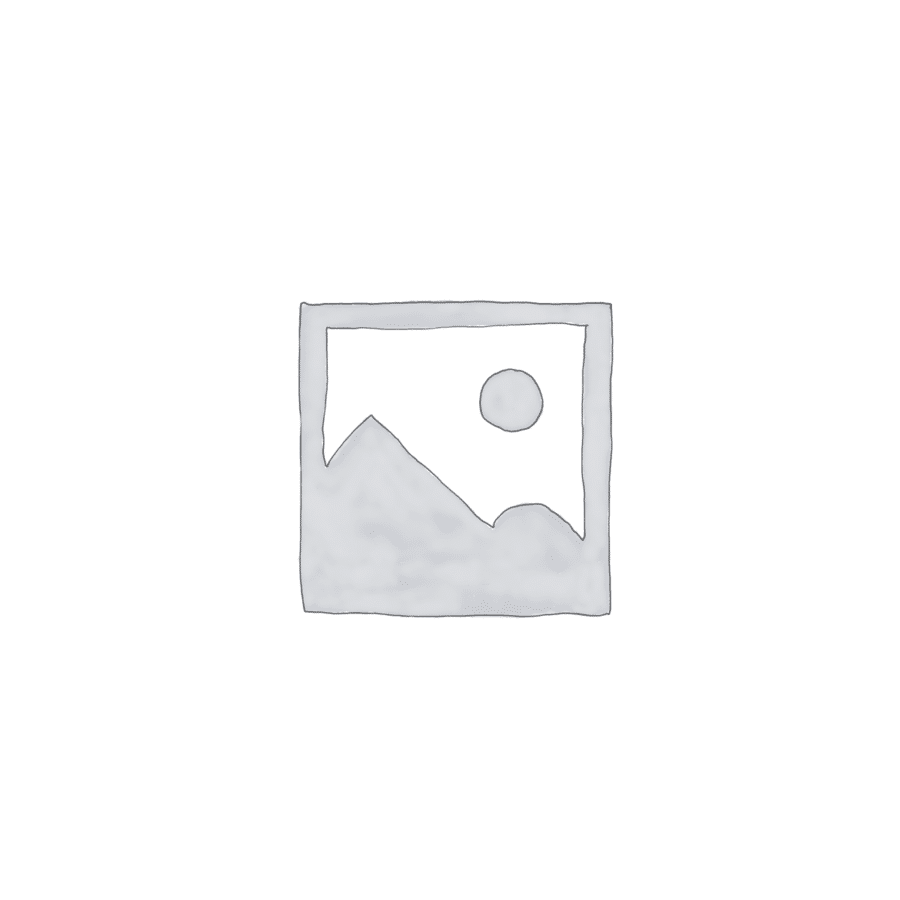

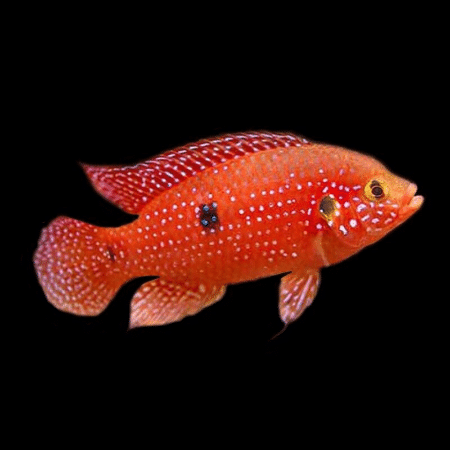
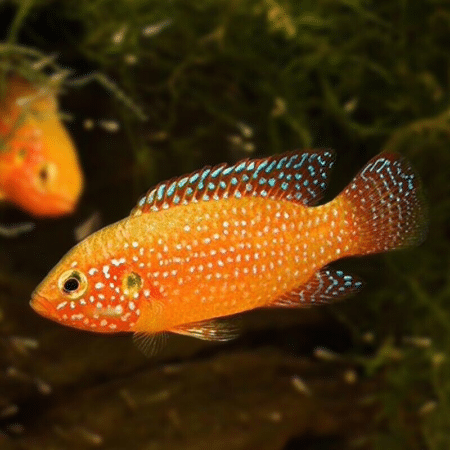
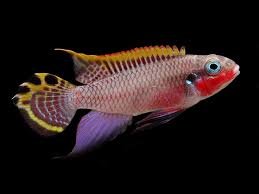




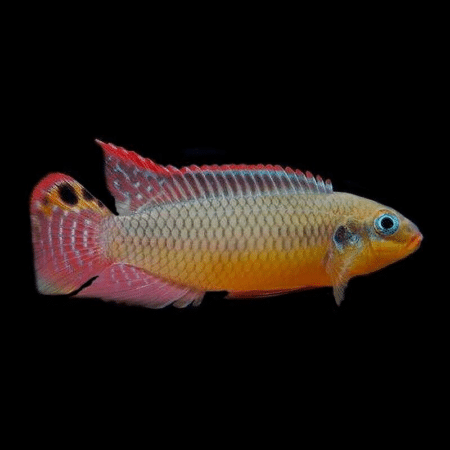
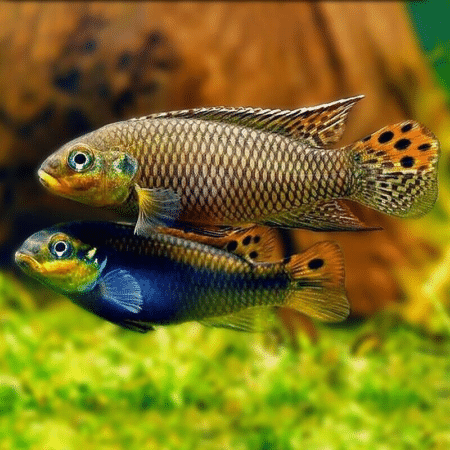

Emily Carter (verified owner) –
I recently added the Pelvicachromis subocellatus ‘Matadi Violet’ to my aquarium, and I couldn’t be happier! After about two months of keeping them, these little beauties have truly captured my heart. The vibrant colors and intricate patterns are mesmerizing to watch, especially during feeding time. I’ve noticed they thrive with high-quality cichlid food, which not only enhances their colors but also keeps them healthy and active. One of my favorite aspects is how they interact with their environment; they love to explore the aquarium substrate, which I specifically chose to mimic their natural habitat. Compared to other cichlids I’ve kept, their personality is much more engaging, making them a joy to observe. The only minor concern was their initial shyness when I first introduced them, but with patience and a little time, they’ve become quite social! I highly recommend these cichlids for both beginners and experienced aquarists—just ensure you have a well-planted tank with appropriate substrate to keep them happy. I will definitely be purchasing more in the future!
Emily Parker (verified owner) –
I recently added the Pelvicachromis subocellatus ‘Matadi Violet’ to my community tank, and I couldn’t be more thrilled! These stunning cichlids are not only vibrant with their lovely violet hues, but they’ve also exhibited such exciting behavior in just a couple of weeks. Watching them explore the intricacies of the aquarium substrate has been a joy!
As a caring fish parent, I chose this particular substrate because it promotes natural digging and hiding spots—essential for their well-being. My fish have thrived since switching from a more generic gravel substrate; the Matadi Violet has created a beautifully crafted environment that closely mimics their natural habitat.
The shipping was prompt, and the cichlids arrived healthy and lively. One minor concern is that they can be a bit territorial, so I would recommend that beginner aquarists ensure they have enough space and hiding spots to keep peace in the tank.
For anyone looking to enhance their freshwater community, I wholeheartedly recommend these beautiful cichlids paired with a suitable aquarium substrate like this. You won’t regret it!